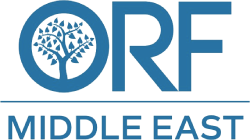Although the Gulf is accustomed to extreme summer heat, projected temperature increases, especially in rapidly urbanising centres, threaten livelihoods, economic growth, and infrastructure. To secure long-term prosperity, the Gulf Cooperation Council (GCC) must implement heat resilience strategies encompassing emergency preparedness, energy efficiency, and sustainable urban design.
Gulf’s Economy Threatened by Rising Temperatures
2024 was the hottest year on record globally, with 2025 trailing closely behind. InAugust, temperatures in the United Arab Emirates (UAE) reached up to 51.8°C, one degree higher than last year’s 50.8°C. The Middle East and North Africa (MENA) region is warming at a pace double the global average, and experts predict it may become partially uninhabitable by the end of the century. The Gulf’s urban population is expected to increase to 90 percent by 2050. As heat intensifies due to the Urban Heat Island (UHI) effect and coastal humidity, climate adaptation becomes paramount. Given the region’s ambitious urbanisation and economic diversification objectives, the Gulf has a public health and socioeconomic imperative to protect its people from extreme heat. This article evaluates the GCC’s existing heat resilience efforts and proposes recommendations to strengthen a concerted and adaptive heat response.
Health and Socioeconomic Costs of Extreme Heat
Climate-induced extreme heat is closely linked to health problems such as heat stroke and exacerbated chronic illnesses. Additionally, heat waves will further impair the health of vulnerable populations such as migrant labourers, straining emergency clinics and profoundly affecting the Gulf’s labour productivity and overall economy. The GCC region could potentially lose up to 369,200 full-time jobs by 2030 due to extreme heat, while MENA could lose up to 14 percent of total GDP without climate action. As diversification objectives prioritise tourism, hotter temperatures may discourage tourists, thus compromising job security for gig economy and service industry workers. To illustrate, Mecca is estimated to experience 182 days of dangerous heat by 2050, exposing millions on Hajj to potential heat-induced illness.
Increased demand for cooling during heat waves destabilises electricity grids, strains limited water resources, and worsens the UHI effect. Air conditioning currently accounts for up to 70 percent of household electricity in the GCC. There are limited government incentives to reduce electricity demands, partly due to the abundance of fossil fuel resources that make large amounts of electricity consumption affordable. The Gulf’s growing data centre footprint brings the challenge of managing the surge in heat generation and water consumption for cooling, especially during summer. Breaking this cycle requires policy approaches that promote energy-efficient systems and shift consumer behaviour.
Regional Initiatives Towards Heat Resilience
In February 2025, the Sixth Arab Regional Platform for Disaster Risk Reduction held a special session on extreme heat, reaffirming regional commitment to strengthening heat resilience. The UAE became the first among the six GCC member states to ratify the Kigali Amendment, signalling commitments to sustainable cooling. The Arab states have improved in building heat wave awareness and enforcing worker protection measures. For example, the GCC demonstrated a three-fold increase in Multi-Hazard Early Warning Systems (MHEWS) reporting since 2015. Moreover, every GCC member has regulated outdoor working hours to protect workers from peak heat. The UAE, Qatar, Bahrain, and Oman have also implemented, respectively, the Heat Exhaustion and Disease Prevention Campaign, the Heat Stress Awareness Campaign, the Heat Action Day, and the SafeSummer campaign to strengthen workplace safety and mitigate heat-induced illnesses.
Despite progress, gaps remain. A few existing disaster management systems are largely reactive and do not address the root causes of extreme heat. Few policies focus on emergency preparedness and long-term adaptation. At 5 percent, the Arab states have the lowest proportion of comprehensive MHEWS. Even the regulation of outdoor working hours can be strengthened, given prior criticisms due to inconclusive data on effectiveness despite high compliance levels.
Policy Recommendations
As the GCC diversifies through tourism, urbanisation, and digital expansion, states should prioritise building comprehensive heat-resilience agendas in tandem with anticipatory National Heat-Health Action Plans (HHAP) and adaptive National Cooling Action Plans (NCAP). Within these plans, states should further the enabling environment for public-private innovation, incentivise collaboration, and reform regulatory frameworks to adapt to extreme heat. This will improve public health, economic savings, and energy cost reductions.
- Anticipate and Respond: Leverage partnerships and technologies to develop tools for heat management
Heat Health Warning Systems (HHWS) and HHAPs are key tools to inform decision-making for emergency preparedness and prevent heat-induced illnesses. HHWS leverage climate forecasts and predetermined heat stress threshold levels to alert communities and inform health interventions. This helps reduce heat-related incidents, improve community awareness, and prevent overburdening of healthcare systems. HHAPs helped Europe avert up to 23 percent of expected heat-related deaths. Although these platforms are historic to the West, they are fairly nascent in the Gulf, with Abu Dhabi developing an official heat-stress index and national HHWS. Gulf countries can leverage insights from similarly heat-struck countries, just like Saudi Arabia’s collaboration with Singapore’s Heat Resilience and Performance Centre. Their efforts centre around formulating policy and regulatory frameworks along with interventions related to occupational heat exposure. Moreover, GCC can seek guidance to build a solid HHAP from key actors like the Global Center on Adaptation (GCA) or Atlantic Council’s Climate Resilience Center (Arsht-Rock).
Given artificial intelligence advancements, urban planners and municipalities can use new technologies to enhance heat vulnerability mapping and emergency preparedness. For example, researchers at MBZUAI and IBM in the UAE are examining AI-powered solutions to detect UHI. In Dubai, industrial companies are adopting thermal sensors to adapt worker schedules to evolving temperature conditions. Similarly, prior to Hajj, Saudi Arabia leveraged smart monitoring systems, including AI-powered drones to monitor crowd flow and sensor-enabled roads to reduce heat. Beyond predictive analytics, the broader Hajj emergency response system successfully liaised between key personnel to strategise medical responses. This case demonstrates an adaptive system that balances technology and stakeholder coordination with the potential to be scaled and embedded within a comprehensive national HHAP. While leveraging AI and advanced technologies aligns with the Gulf’s respective Vision plans, governments should formulate policies of good practice, further incentives and subsidies to scale integration.
- Adapt Long-Term: Emphasise energy-efficient cooling and passive urban design within National Cooling Action Plans (NCAPs) and urban planning guidelines
While HHAP helps anticipate and inform heat response, National Cooling Action Plans (NCAPs) advise sustainable cooling strategies for long-term adaptation. The GCC should establish an energy-efficient cooling policy framework that prioritises retrofitting for older buildings and district cooling (DC) for new developments, eventually building towards comprehensive NCAPs.
Retrofitting consists of the modernisation and integration of smart controls within existing HVAC systems that regulate indoor temperatures, minimising electricity consumption by up to 50 percent. In Gulf countries such as Kuwait, where electricity is heavily subsidised, homeowners may be dissuaded from pursuing energy-efficient upgrades due to their high cost. The UAE and Saudi Arabia have started programmes incentivising AC upgrades, but retrofitting remains largely underutilised, pointing to a need for financing incentives such as mandatory energy audits, tax credits, and rebate programmes.
District Cooling (DC) systems deliver centralised cooling to multiple buildings, offering energy efficiency and cost savings of at least 40 percent over conventional cooling. Currently, Saudi Arabia, Qatar, and the UAE have invested heavily in DC systems, but lack clear policy frameworks for further technology development. Oman, Bahrain, and Kuwait have also piloted DC but encounter scaling challenges due to high installation and operational costs. Solutions include urging governments to treat DC as a utility, regulate tariffs, and set clear technical codes. Nevertheless, project finance remains a looming issue, as banks are hesitant to extend long-term debt without promised offtake agreements.
Long-term adaptation to extreme heat requires climate-sensitive urban planning that mitigates the UHI effect. The Gulf Organisation for Research & Development (GORD) recently unveiled the GCC’s first Sustainable Construction Code, which promotes locally-rooted design standards prioritising energy and water efficiency. This builds upon Oman’s National Urban Design Guidelines and the UAE’s Plan Abu Dhabi 2030, which highlight passive cooling techniques such as strategic shading, double glazing, wind towers, and thermal massing that naturally reduce indoor temperatures and residential energy consumption by over 20 percent. Urban greening initiatives such as neighbourhood afforestation and green roofs also help reduce heat absorption, but need to be cautiously implemented to avoid straining limited water resources. Ensuring the success of new regional guidelines will require incentives, monitoring, and enforcement.
Leigh Mante is a Junior Fellow, Climate and Energy at ORF Middle East.











